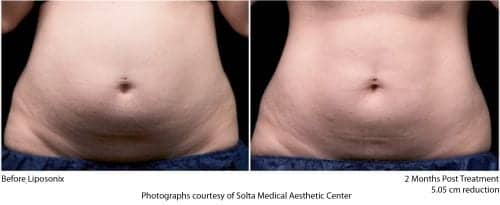During the last few years, aesthetic energy device (AED) technology has continued to improve and expand into exciting new areas that will change the way many of us approach aesthetic medicine. An important recent advance is the introduction of high-intensity focused ultrasound (HIFU) as a way to reduce fat around the abdomen and flanks.
While HIFU is new to medical aesthetics, it has been used by oncologists and researchers over the last 10 years to treat conditions ranging from cancers to fibroids. These uses have established a favorable safety profile for the technology, and its application in aesthetics for noninvasive fat reduction was recently cleared by the FDA in the Liposonix® device from Solta Medical, Hayward, Calif.
MEET THE NEW LIPOSONIX

The Liposonix system works by focusing HIFU energy at a depth of 1.3 centimeters, causing rapid heating of the fat tissue just beneath the skin surface in the abdomen and flanks. The fat targeted by HIFU is heated to 56oC, destroying adipocytes that are subsequently absorbed in 8 to 12 weeks, leaving behind a slimmer, more contoured waistline. Patients typically experience some mild pain during the procedure, which can be managed by premedication and proper positioning during treatment. While some soreness and bruising are frequent after the procedure, there is no downtime and patients can immediately return to their normal activities.
The first generation of Liposonix has been used in Europe since 2008. The device recently introduced in the United States is a second generation with significant improvements in form and functionality. Specifically, the treatment area of the transducer has increased with the new system, allowing for a quicker treatment; the energy delivery options have been broadened, allowing more flexibility in the treatment to accommodate the patient’s pain tolerance; and the machine itself has a sleeker, more user-friendly design.
LOSE AN INCH IN AN HOUR
While these improvements are important, the real question for me and my patients always centers on the results. As one of the first practices to offer the device in the US, I relied at first on the results of the clinical trials, which demonstrated an average waist-circumference reduction of approximately 2.6 centimeters (1 inch) after a single treatment. These results have been supported by my clinical experience treating more than 50 female and male patients of all shapes, sizes, and ages.
Many of these patients sought treatment after seeing one of the news stories on Liposonix and reading Solta Medical’s educational materials online, which note that patients can lose 1 inch in 1 hour with one treatment. I have seen interest from an impressive variety of patients going beyond the typical aesthetic patient profile, from a 69-year-old recently retired man to a 35-year-old woman who was getting ready for her wedding. This speaks to the wide appeal that a safe, effective, and quick noninvasive fat-reduction treatment can have across many patient demographics, which can be a gateway to expand our practices significantly. Millennium Research Group estimates that the noninvasive fat reduction market will grow by 42% annually through 2016—nine times faster than its surgical counterparts.1
MANAGING PATIENT EXPECTATIONS
To assure patient satisfaction, it is crucial to have a candid discussion with a patient about his or her areas of concern and desired outcome, take quality before-and-after pictures, and talk explicitly about what the procedure can and cannot correct, as well as the expected response rate, which in my experience is about 90%. I also assess the pain tolerance of my patients prior to treating and often administer a nonsteroidal pain medicine as a way to help make the treatment as tolerable as possible.
As with most treatments, there is wide variation in pain tolerance, with some patients having no problem tolerating the treatment while others displaying a low tolerance threshold. If I have a patient who indicates that they have a very low pain threshold, I will start them out on a lower setting and then increase the energy if I believe they can tolerate the higher setting. I also always remind my patients that Liposonix is not designed as a weight-loss alternative. The best way to maximize the treatment benefit is to maintain a healthy lifestyle and eating habits.
Offering patients a noninvasive fat-reduction treatment that relies on HIFU technology has met a growing need in my practice, including several patients who would not otherwise consider an aesthetic procedure.
Anne Chapas, MD, is an assistant clinical professor at New York University School of Medicine, and founder and medical director of Union Square Laser Dermatology in New York City. She can be reached via [email protected].
REFERENCE
- Millennium Research Group Inc. US Markets for Body Contouring Devices 2012.


